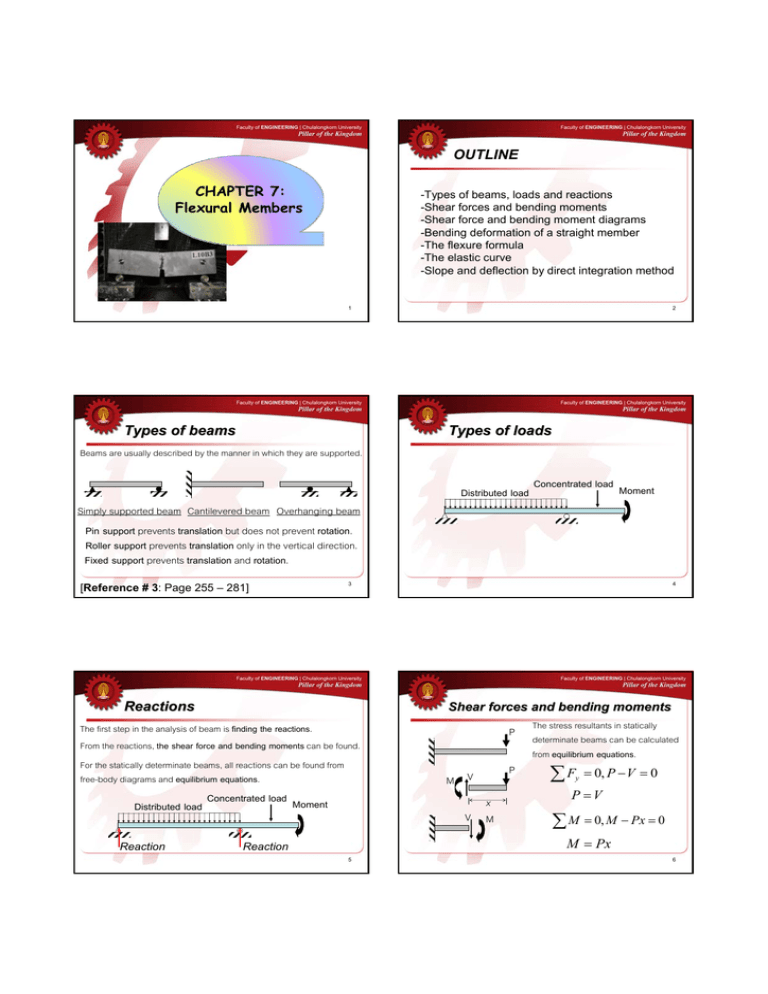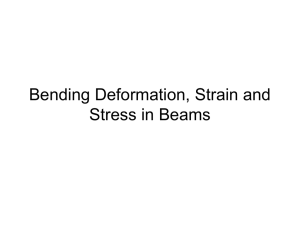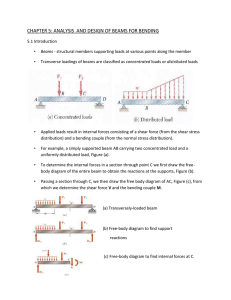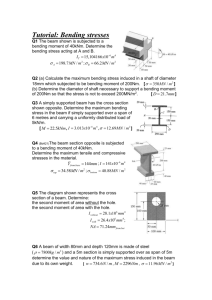CHAPTER 7: Flexural Members OUTLINE
advertisement

OUTLINE CHAPTER 7: Flexural Members -Types of beams, loads and reactions -Shear forces and bending moments -Shear force and bending moment diagrams -Bending deformation of a straight member -The flexure formula -The elastic curve -Slope and deflection by direct integration method 1 Types of beams 2 Types of loads Beams are usually described by the manner in which they are supported. Distributed load Concentrated load Moment Simply supported beam Cantilevered beam Overhanging beam Pin support prevents translation but does not prevent rotation. Roller support prevents translation only in the vertical direction. Fixed support prevents translation and rotation. [Reference # 3: Page 255 – 281] 3 Reactions The first step in the analysis of beam is finding the reactions. From the reactions, the shear force and bending moments can be found. For the statically determinate beams, all reactions can be found from free-body diagrams and equilibrium equations. Distributed load Reaction 4 Shear forces and bending moments P The stress resultants in statically determinate beams can be calculated from equilibrium equations. P M V Concentrated load Moment V x M ∑F y = 0, P − V = 0 P =V ∑ M = 0, M − Px = 0 M = Px Reaction 5 6 Sign convention V V A positive shear force acts clockwise against the material. M M A positive bending moment compresses the upper part of the beam. M V P M+M1 dx V+V 1 M0 M+M1 M V dx V+V 1 7 Homework # 21: Reference # 3 Problem 6-3 Shear force and bending moment diagrams P Relationship between loads, shear forces and bending moments q From equilibrium equations, M V M+dM dV dM = −q =V dx V+dV dx dx ⎛ dx ⎞ V1 = − P M 1 = P⎜ ⎟ + Vdx + V1dx ⎝ 2 ⎠ M 1 = −M 0 8 Shear force and bending moment diagrams P q P P2 3 q 1 SFD SFD BMD BMD 9 P1 Shear force and bending moment diagrams P2 10 Draw the SFD and BMD q P P b L SFD M1 L/3 BMD 11 b M1=PL/4 P L/2 L/2 q0 2M1 L/3 L/3 L Homework # 22: Reference # 3 Problem 6-30 12 Bending deformation of a straight member Bending deformation of a straight member Compression Tension Need Reinforcement! x z SFD BMD Δs = Δx Undeformed element Δs '− Δs Δs →0 Δs ( ρ − y )Δθ − ρΔθ ∈= lim Δθ →0 ρΔθ y ∈= − ρ ρ Δθ Δx ∈= lim longitudinal axis Δs’ y Bending deformation of a straight member “Longitudinal normal strain will vary linearly with y from NA” − ∈max ∈ − y/ ⎛ y⎞ c ∈= −⎜ ⎟ ∈max = ⎝c⎠ y ∈max c/ longitudinal axis ρ Δx 14 o’ y longitudinal axis neutral surface 13 Bending deformation of a straight member Δx Δx Normal strain distribution 15 16 The flexure formula x σ max M σ The flexure formula ∈max c y FR = ∑ Fx ; 0 = ∫AdF = ∫AσdA ⎛ y⎞ = ∫ − ⎜ ⎟σ max dA A ⎝c⎠ = c ∫ A Bending stress variation σ max y ⎛ y⎞ ⎝c⎠ σ = −⎜ ⎟σ max Normal strain variation y x ⎛ y⎞ ∈= −⎜ ⎟ ∈max ⎝c⎠ Deformed element ρ y y z Reinforcement [Reference # 3: Page 282 – 303] ∈ x Δx neutral axis longitudinal axis M x M+ y y z − σ max c ∫ A ydA M σ y x Bending stress variation (M R )z = ∑ M z ; M = ∫A ydF = ∫A y(σdA) ⎞ ⎛y = ∫ y⎜ σ max ⎟ dA A ⎠ ⎝c ydA = 0 17 σ max = c M= σ max c ∫ A y 2 dA σ =− Mc I My I I = The moment of inertia of the crosssectional area about NA 18 Example Example If the beam has a square cross section of 100 mm on each side, determine the absolute maximum bending stress in the beam. 1.2 kN If the beam has a rectangular cross section with a width of 200 mm and a height of 400 mm, determine the absolute maximum bending stress in the beam. 8 kN/m A 8 kN B 0.8 m 10 kN 2 kN/m 40 kN·m 400 mm 0.8 m 4m 6m 200 mm 19 The elastic curve Sign convention The elastic curve = the deflection diagram of the longitudinal axis that passes though the centroid of each cross-sectional area of the beam. Force Displacement Moment Rotation or slope +M +M A positive bending moment compresses the upper part of the beam. Positive internal moment P P -M -M Negative internal moment 21 [Reference # 3: Page 569 – 589] Inflection point M 22 MomentMoment-curvature relationship P2 P ds P1 y longitudinal axis dx 1 ρ =− ∈ y Before deformation BMD 1 Inflection point ρ Elastic curve Homework # 24: Reference # 3 Problem 12-15 23 = M EI longitudinal axis y o’ ρ ρ dθ M Inflection point 20 Homework # 23: Reference # 3 Problem 6-62 ds’ dx M After deformation 24 Slope and displacement by integration Represent the curvature in terms of v and x; 1 From Simplify by ρ 1 ρ = = 1 1 ( ) ρ ρ d 2 v / dx 2 [1 + (dv / dx) ] 2 3/ 2 d 2 v / dx 2 M ; EI d 2v dx 2 = Slope and displacement by integration [1 + (dv / dx) ] 2 3/ 2 = M EI d 2v M = dx 2 EI ; From d 2v M = dx 2 EI From V= From −w= ; dM ; dx dV ; dx EI d 2v = M ( x) dx 2 EI d 3v = V ( x) dx 3 EI d 4v = − w( x) dx 4 25 26 Sign convention Boundary conditions +w +M If positive x is directed to the left, then θ will be positive clockwise. +M +V +V Positive sign convention v o’ +ρ +ρ ds +dv +v Δ=0 Pin Δ=0 Roller θ=0 Δ=0 Fixed end V=0 M=0 Free end Δ=0 Pin Elastic curve dθ +θ x +x Δ=0 Roller dx M=0 Internal pin or hinge 27 Example Example Determine the equations of the elastic curve using the x1 and x2 coordinates. EI is constant. P A a x2 Determine the maximum deflection of the beam and the slope at A. EI is constant. M0 M0 A B x1 28 b B a a a L 29 Homework # 25: Reference # 3 Problem 12-13 30







